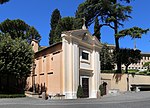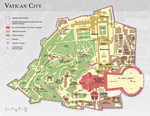Grotta di Lourdes
Buildings and structures in Vatican City

Grotta di Lourdes (also Grotta della Madonna di Lourdes) is an artificial cave in the Vatican gardens. It was built in 1902–05 and is a replica of the Lourdes Grotto in France. The context of building this grotto is the vision of the Madonna that a young girl, Bernadette Soubirous, experienced 18 times. Prior to that the Pope had promulgated the dogma of the Immaculate Conception in 1854.Pope Francis, two days after his election as Roman Pontiff, visited the Grotto of Our Lady of Lourdes on the afternoon of 15 March 2013 and offered prayers before the statue of the Virgin Mary.
Excerpt from the Wikipedia article Grotta di Lourdes (License: CC BY-SA 3.0, Authors, Images).Grotta di Lourdes
Viale Benedetto Quindicesimo,
Geographical coordinates (GPS) Address Nearby Places Show on map
Geographical coordinates (GPS)
| Latitude | Longitude |
|---|---|
| N 41.902777777778 ° | E 12.448333333333 ° |
Address
Viale Benedetto Quindicesimo
Viale Benedetto Quindicesimo
00120 , Vatican City
Vatican City
Open on Google Maps










